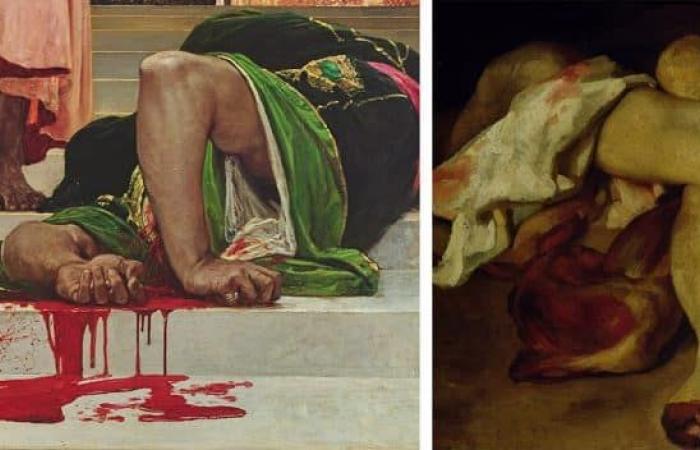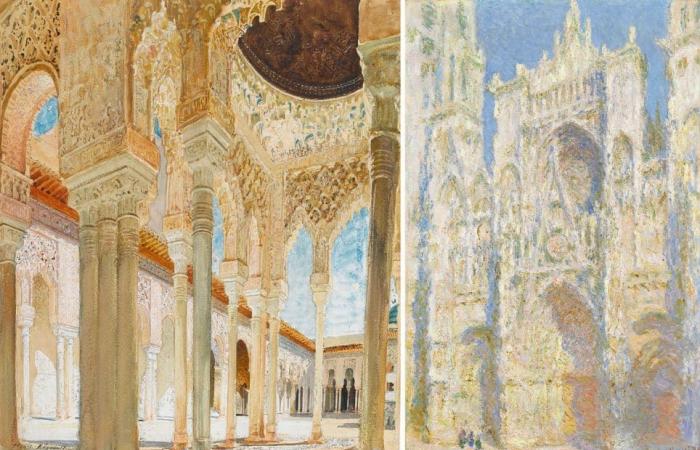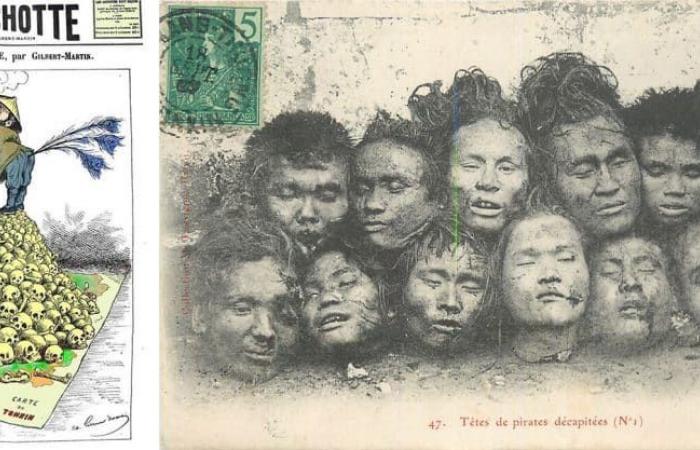Before our eyes, a head rouleboule on the steps of a palace. The viewer is petrified, Medusa's head could not have done better. Thunderous low angle, the composition verticale falls like a playing card, like a monumental clean cut. But this time, it's not Lewis Carroll's hysterical lady of the heart shouting wildly: “Let's cut off his head!” “.
Our face imposes its calm. Is this a king or a jack? Or rather a sultan or a janissary? The masterful swordsman has just accomplished his crime, wiping his blade on the half-raised side of his dress. He stands above his victimas a sovereign, crowned with a red fez, draped in precious pink. His look is both disdainful and melancholy. He seems detached too, but not as detached as his victim.
Henri Regnault, Execution without trial under the Moorish kings of Granada1870
i
oil on canvas • 301 × 143 cm • Coll. Orsay Museum, Paris • © Bridgeman Images
The tortured man's head still splashes on the steps of the palace. Threads of blood are projected by a reflux of blood pressure, twirling like Pollock's brush. The mouth twists, eyes frozen in fear are still riveted towards the executioner. His contracted features turn green, almost matching the collapsed outfit. The pine velvet of his Turkish pants stretches on the ground, on his side.
Fine gold embroidery on the sleeves brings out a silkier olive green. His last reflex is frozen, in a composition close to the Anatomical pieces by Théodore Géricault (1819). The elbow folded into a perfect square is illuminated at its tip. The arm falls right in the axis of the trachea. hands closed are bathed here in a thick puddle of blood.
On the left, a detail from “Execution without trial under the Moorish kings of Granada” by Henri Regnault, 1870. On the right, “Anatomical pieces” by Théodore Géricault, 19the century
i
Oils on canvas • Coll. Musée d'Orsay, Paris / Coll. Coll; Museum of Fine Arts, Rouen • © Bridgeman Images
The terrifying scene is nestled in the gold of a palace of the Arabian Nights, topped by a stalactite vault tinted with pink and orange. There Moorish dome is riddled with sparkling points of light. Outside, we imagine a bright sun, not even to mention the heat. Upstairs, a moucharabieh perhaps conceals the women of a harem.
Everywhere, the arabesques dance with the embroidered sculptures. Where are we ? In Granada, Isfahan, Bukhara or Samarkand? The eye hesitates, twirls up there as if on a flying carpet. The descent is brutal. Despite the warm colorsnothing helps, we remain frozen in the face of the severed head. There’s some Caravaggio in there, right? Without chiaroscuro, with sparkles.
Granada, from Tangier
Henri Regnault (1843–1871) directed l’Execution without trial under the Moorish kings of Granada in 1870. At 27, he was one of the most talented of his generation. This tenant of the Villa Médicis asked to explore the colors of Spain and Morocco. “How can we be satisfied with white ceilings with cupids painted pink and doves pecking each other? », he wrote in 1869 from Madrid, where he left with his artist friend Georges Clairin.
These two stopped in Granada. HAS the AlhambraRegnault creates watercolors in series, future settings for his next paintings. Its columns in the Cour des Lions are reminiscent of Claude Monet's cathedrals. Under the domes, he confesses “a sort of vertigo at height, which sucks you in and pumps you up and you almost feel lifted from the earth”. To a certain Mr. Butin, he wrote in September 1869: “If you only saw what Charles V dared to have built on the site of part of the Arab palace! You would shrug your shoulders and want to resurrect him and spit in his face. »


On the left, “The Court of Ambassadors at the Alhambra Palace” by Henri Regnault. On the right “Rouen Cathedral, the portal, the sun” by Claude MonetXIXe century – 1894
i
Watercolor, graphite, gouache / Oil on canvas • 55 × 49 cm – 100.5 × 65.8 cm • Coll. Musée d'Orsay, Paris / Coll. National Gallery of Art, Washington • © GrandPalais Rmn. © NGA
THE correspondences of Regnault are a treat. In October, he wrote to Duchess Colonna: “How can we leave here? In the rooms there are ceilings made of stalactites which, joined together and superimposed, rise in the shape of a dome and draw stars, geometric figures which intersect. All these places are steeped in history, the Salle des Abencérages in particular. The last Moorish king of Granada, Boabdilallegedly had his rivals massacred there in 1492.


Photograph representing Georges Clairin and Henri Regnault accompanied by a man, in Tangierfin 1869–1870
i
Print on paper laminated on cardboard • Coll. INHA library, Paris • © INHA
This sovereign, in captivity between 1484 and 1487, was freed thanks to a pact with the Catholic Ferdinand of Aragon. Accused of treason by the Abencérage clan, Boabdil would have introduced the 36 rival chiefs one by one into the eponymous room to decapitate thembefore exposing their heads in the basin of a fountain. For many observers, Regnault's “Executioner without judgment” wiping his saber would be the famous Boabdil.
“See that I am up to my neck in severed heads. »
An 1869, Regnault line up in Tangiertaking the sketches and pastels from Granada among others. With Clairin, they bought and transformed a house into a “little Alcazar”. In their patio draped and set with small pieces of Alhambra, the models parade. Among the paintings of the period, in Tangier as in Rome, a theme often recurs: severed head. In particular, he carries out a Salome posing with saber and tray before taking off Jean-Baptiste, as well as a Judith presented in full cutout of Holofernes.
Describing these paintings, Regnault wrote to a friend in April 1869: “See that I am up to my neck in the severed heads.” The following year, he sent from Tangier his Execution without trial under the Moorish kings of Granada who will be a real successpraised in particular by the hemophiliac Gauthier: “Mr. Regnault has his own way of conceiving a subject, of treating it, of bringing out an unexpected effect”. That's saying something.
Morbid reflections
“Bringing back to life the real Moors, rich and great, terrible and voluptuous at the same time, those that we only see in the past. »
Execution without judgment under the Moorish kings of Granada East a horror film framing. The visitor stops in front of the painting as one turns around in front of an accident on the highway. It comes from the soft fascinationhorror tourism – Orsay-catacombs, group ticket. Visitors parade, terrified, excited, reassured too. The head rolling down the marble staircase isn't ours, is it?
In his critique of the painting, Théophile Gautier – almost fanatical idol of Regnault – also salutes “the superb gesture of the vigilante. The justiciar, because the name executioner cannot suit this noble and majestic figure.” However, it is an “Execution without trial”, the cartel tells us. We are far from Father Salomon who weighs the pros and cons. But whatever, justice is not the subject. It is even the heart of the off-topic.


On the left, Don Quixote No. 668, Le Tonkinese in Algeria by Gilbert-Martin. On the right, postcard “Decapitated pirate heads (n°1)” in Tonkin
i
© Hemis / Alamy. © Drouot
Regnault’s desire? He wrote it in his letters: “Bringing back to life the true Moors, rich and great, terrible and voluptuous at the same time, those whom we only see in the past”. In other words, the artist invents. Terrible paradox: he, the lover of Islam (as well as a host of orientalists) inoculates into the Western collective unconscious the image of the oriental despot devoid of humanity. In the Metropolis, spectators are inundated by a stream of beheadings that they see as the truth – ouch! Twice ouch even, because the future IIIe Republic, so colonial, will take advantage of these images broadcast throughout France to legitimize its “civilizing” mission of “barbarian” peoples.
Three times ouch, if we follow the trajectory of the soon-to-be barbaric “civilizers” (without quotation marks). For example, within fifteen years, Ferry's France will behead the “pirates” of Tonkin before publishing, in postcard format, “trophy” heads. A controlled mass production this time, to frighten those who would like to challenge the colonial empire. Here is the historical reality which joins orientalist fantasies… Between these two universes carried by images, the skulls roll, to terrorize insurgents or subjugate a spectator.
Unlike his friend Clairin, Regnault does not fall into a sordid and petty overbidding. You have to see the scene of his Tangier roommate: the smiling executioners, the king holding out his severed head to children ready to play with it like a balloon. Sordid summit, dubious intentions. Regnault suggests something else. He who is inhabited by deadly thoughtshe who will fall next year at the battle of Buzenval with a bullet (in the head), what does he tell us with his Execution without judgment ?


Georges Clairin, The Massacre of the Abencerages1874
i
Oil on canvas • 451.5 × 320.5 cm • Coll. Museum of Fine Arts, Rouen • © Bridgeman Images
It's not easy to fathom his terrifying tête-à-tête: by bringing together the two very similar skulls, a mirror reflectionalmost a challenge. The detached stares at his tormentor, burning his eyes. The swordsman does not seem so indifferent to his memento mori all hot. Meditation in progress. And if Regnault – fiddling with his personal anxieties – transposed a destruction of man by man ? For once, his orientalist fantasy would meet a historical reality.
France











